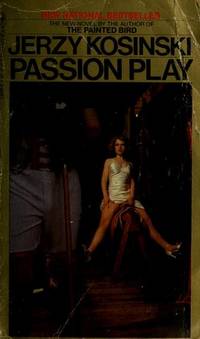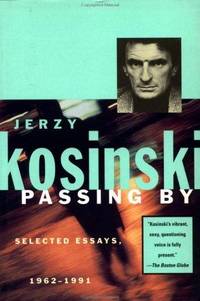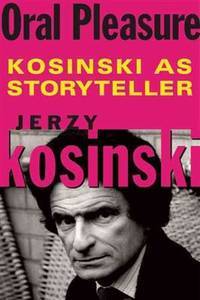Jerzy Kosinski (1933 – 1991)
Jerzy Kosiński (name bestowed upon him by his father while they were hiding from the Nazis, original name: Josek Lewinkopf) (June 18, 1933 – May 3, 1991) was a Polish-Jewish English-language novelist, who acquired American citizenship.
Early life, teaching, and marriage
He was born in Łódź. As a child during World War II, he survived under a false identity in a Roman Catholic Polish family in eastern Poland. A Roman Catholic priest had issued him a forged baptismal certificate.
After World War II, Kosiński was reunited with his parents and earned degrees in history and political science in Poland (at the University of Łódź). He worked as an assistant at the Polish Academy of Sciences (Institute of History and Sociology), and in 1957 emigrated to the United States.
He graduated from Columbia University, and was a fellow of Guggenheim (1967), the Ford (1968), and the American Academy (1970).
In the USA he was a lecturer at Yale, Princeton, Davenport University, and Wesleyan. In 1965 he became an American citizen.
In 1962 he married the eighteen years his senior American steel heiress Mary Hayward Weir, who in 1968 died of brain cancer. He later married Katherina von Fraunhofer, a descendant of Bavarian aristocracy.
Novels
Kosiński is perhaps best known for his novels The Painted Bird (1965), Steps (1968), and Being There (1971). Almost all of Kosinski's novels were on the New York Times Best Seller list, and they were translated into over 30 languages, with total copies estimated at 70 million in 1991.
The Painted Bird
The Painted Bird describes the experiences of a boy (of unknown religious and ethnic background) wandering about a surreal Polish countryside and hiding among cruel peasants. The novel is presumably a metaphor for the human condition: alienation in a dehumanized, hostile, and thoroughly evil world.
“For years Kosiński passed off The Painted Bird as the true story of his own experience during the Holocaust,” wrote D. G. Myers, Associate Professor of English at Texas A&M University. “Long before writing it he regaled friends and dinner parties with macabre tales of a childhood spent in hiding among the Polish peasantry. Among those who were fascinated was Dorothy de Santillana, a senior editor at Houghton Mifflin, to whom Kosiński confided that he had a manuscript based on his experiences.” (from Myers' review of Jerzy Kosinski: A Biography by James Park Sloan)
The question of poetic license
It was "described by Arthur Miller and Ellie Wiesel [sic] as one of the most important books in the so-called Holocaust literature." [2] Wiesel wrote in The New York Times Book Review that it was: "One of the best... Written with deep sincerity and sensitivity" - claims an advertisement by Barnes & Noble.
“When Kosiński's Painted Bird was translated into Polish - wrote Iwo Cyprian Pogonowski, Adjunct Professor of Civil Engineering from Virginia State University, and author of a 1998 book on the subject of Polish Jewish history - it was read by the people with whom the Lewinkopf family lived during the war. They were scandalized by the tales of abuse that never happened. They recognized names of Jewish children sheltered by them during the war - children who survived thanks to them, now painted as victims of their abuse. They were bitter and offended by Jerzy's ingratitude and obsession to slander them.” According to Pogonowski, The Painted Bird - due to its "pornographic content" - became Kosiński's most successful attempt at profiteering from the Holocaust.
Irena Tomaszewska, author of a 1994 book Żegota – The Rescue of Jews in Wartime Poland, in a 22 page Report published by the Polish-Canadian Congress wrote that Kosiński's falsification of history resulted in the "gradual shifting of responsibility for the Holocaust from the Nazis to the Poles." (quote in Polish only)
Norman Finkelstein, an assistant professor of political science at DePaul University, a son of Holocaust survivors and a controversial figure himself , commented on Wiesel's review by stating in his controversial yet highly acclaimed book The Holocaust Industry: "Long after Kosinsky was exposed as a consummate literary hoaxer, Wiesel continued to heap encomiums on his "remarkable body of work."
The American Jewish writer Howard Weiss reflected on Holocaust literary hoaxes: "Presenting a fictional account of the Holocaust as factual only provides ammunition to those who already deny that the horrors of Nazism and the death camps ever even happened. If one account is untrue, the deniers' reasoning goes, how can we be sure any survivors accounts are true ..." ( from an essay published by Weiss in the Chicago Jewish Star)
Marketing "fiction"
However, though some readers assumed it was based on the author's experiences during World War II, the book was in fact published and marketed as "fiction." Most of the events depicted are now widely considered to be fictional.
Richard Kluger, reviewing it for Harper's Magazine, wrote: "Extraordinary... literally staggering ... one of the most powerful books I have ever read."
And John Yardley, reviewing it for The Miami Herald, wrote: "Of all the remarkable fiction that emerged from World War II, nothing stands higher than Jerzy Kosinski's The Painted Bird. A magnificent work of art, and a celebration of the individual will. No one who reads it will forget it; no one who reads it will be unmoved by it. The Painted Bird enriches our literature and our lives."
Anti-Polonism
Some readers accused Kosiński of anti-Polonism. Dr. Dariusz Ratajczak, Polish lecturer at Opole University's Institute of Historical Studies wrote at length about Kosiński's Slavic “Untermensch” in his 1999 collection of essays entitled Niebezpieczne tematy (Dangerous subjects). Ratajczak was suspended from teaching for explaining Holocaust revisionism and was brought before the Polish court.
Others argued that The Painted Bird is a misinterpretation of the metaphoric nature of the novel. In newer editions Kosiński explained that his characters' nationality and ethnicity had intentionally been left ambiguous in order to prevent that very interpretation.
Steps
Steps (1968), a novel comprising scores of loosely connected vignettes, won the National Book Award in 1969.
Being There
Being There was made into a 1979 movie directed by Hal Ashby, starring Peter Sellers. The screenplay was written by Kosiński and the award winning screenwriter Robert C. Jones. It won the 1981 British Academy of Film and Television Arts (Film) Best Screenplay Award, as well as the 1980 Writers Guild of America Award (Screen) for Best Comedy Adapted from Another Medium. It was also nominated for the 1980 Golden Globes Best Screenplay Award (Motion Picture).
Controversy: claims of plagiarism
According to Eliot Weinberger, an American writer, essayist, editor and translator, Kosiński was not the author of the book. Weinberger alleged in his 2000 book Karmic Traces that Kosiński was not fluent in English at the time of its writing.
In June 1982, a Village Voice article by Geoffrey Stokes and Eliot Fremont-Smith accused Kosiński of plagiarism, claiming much of his work was derivative of Polish sources unfamiliar to English readers. (Being There bears a strong resemblance to Kariera Nikodema Dyzmy — The Career of Nicodemus Dyzma — a 1932 Polish bestseller by Tadeusz Dołęga-Mostowicz). They also alleged that Kosiński wrote The Painted Bird in Polish, and had it secretly translated into English. The article also claimed that Kosiński's books had actually been ghost-written by his "assistant editors," pointing to stylistic differences among Kosiński's novels, depending upon his free-lance editors for "the sort of composition that we usually call writing." New York poet, publisher and translator, George Reavey, who in American biographer James Sloan's opinion was embittered by his own lack of literary success, claimed to have written The Painted Bird for Kosiński. Reavey's assertions were ignored by the press.
The article presented a different picture of Kosiński's life during the Holocaust — a view which was later supported by a Polish biographer, Joanna Siedlecka, and Sloan. The article asserted that The Painted Bird, assumed by some to be semi-autobiographical, was a work of fiction. The article maintained that rather than wandering the Polish countryside, Kosiński had spent the war years in hiding with a Polish Catholic family and had never been appreciably mistreated.
Reaction to article
The Voice reporters offered the testimony of several free lancers formerly in Kosinski's part-time employ, including Barbara Mackey, the assistant who worked on The Devil Tree. When she was contacted by the Washington Post Book World, however, for a follow-up story, she insisted, "I did nothing but editing," and went on to criticize what she called the Village Voice's "shoddy journalism." Furthermore, she continued, the article's authors asked her "leading questions," asserts one anonymous webpage featuring claims proven false about Kosiński's wartime experience.
In a Publishers Weekly article, Les Pockell, the editor of Passion Play and The Devil Tree, said that the charges were "totally ludicrous. It's clear no one in the article is asserting that he or she wrote the book." Because Kosinski was "obsessive" about his writing, Pockell continued, "he retained people to copy edit." Pockell told the Los Angeles Times Calendar that he felt the article's authors "played upon the ignorance of the general public about the conventions of publishing," and "to turn Kosinski's working methods into something sinister makes one wonder about their motives," alleges the same anonymous webpage.
Austen Olney, editor in chief of Houghton Mifflin, wrote in a letter to the Village Voice:
"I have been marginally involved with the three Kosinski novels published by Houghton Mifflin and can attest to the fact that he is a difficult and demanding author who makes endless (and to my way of thinking often niggling) corrections in proof. I have been sometimes overwhelmed by his flamboyant conceits and his artful social manipulations, but I have never had any reason to believe that he has ever needed or used any but the most routine editorial assistance. The remarkable consistency of tone in all his novels seems to me sufficient evidence that they all come from his hands alone."
Terence Blacker, an English publisher (who published Kosinski's books) and author of children's books and mysteries for adults, wrote in response to the article's accusations in his article published in The Independent in 2002:
"The significant point about Jerzy Kosinski was that ... his books ... had a vision and a voice consistent with one another and with the man himself. The problem was perhaps that he was a successful, worldly author who played polo, moved in fashionable circles and even appeared as an actor in Warren Beatty's Reds. He seemed to have had an adventurous and rather kinky sexuality which, to many, made him all the more suspect. All in all, he was a perfect candidate for the snarling pack of literary hangers-on to turn on. There is something about a storyteller becoming rich and having a reasonably full private life that has a powerful potential to irritate so that, when things go wrong, it causes a very special kind of joy."
John Corry, a controversial figure himself wrote a 6,000-word feature article in The New York Times in November 1982, responding and defending Kosinski, which appeared on the front page of the Arts and Leisure section. Among other things, Corry alleged that reports claiming that "Kosinski [sic] was a plagiarist in the pay of the C.I.A. were the product of a Polish Communist disinformation campaign."[19]
Kosiński's defenders also assert that these accusations ignore the stylistic differences apparent in the work of almost any artist over a period of more than a few years.
Kosiński himself responded that he had never maintained that the book was autobiographical, even though years earlier he confided to Dorothy de Santillana, a senior editor at Houghton Mifflin, that his manuscript "draws upon a childhood spent, by the casual chances of war, in the remotest villages of Eastern Europe.". In 1988 he wrote The Hermit Of 69th Street, in which he sought to demonstrate the absurdity of investigating prior work by inserting footnotes for practically every term in the book. "Ironically - wrote theatre critic Lucy Komisar - possibly his only true book... about a successful author who is shown to be a fraud." (from the same article)
TV, radio, film, and newspaper appearances
Kosiński appeared 12 times on The Tonight Show with Johnny Carson during 1971-73 and The Dick Cavett Show in 1974, was a guest on the talk radio show of Long John Nebel, posed half-naked for a cover photograph by Annie Leibovitz for the New York Times Magazine in 1982, and presented the Oscar for screenwriting in 1982.
He also played the role of Bolshevik revolutionary and Politburo member Grigory Zinoviev in Warren Beatty's film Reds. The Time magazine critic wrote: "As Reed's Soviet nemesis, novelist Jerzy Kosinski acquits himself nicely--a tundra of ice against Reed's all-American fire." Newsweek complimented Kosinski's "delightfully abrasive" performance," alleges the quoted anonymous website [22]
Suicide
In 1979 Kosinski told a reporter: "I'm not a suicide freak, but I want to be free. If I ever have a terminal disease that would affect my mind or my body, I would end it."
Kosiński committed suicide on May 3, 1991, by taking a fatal dose of barbiturates and his usual rum-and-Coke, twisting a plastic shopping bag around his head and taping it shut around his neck (a method of suicide suggested by the Hemlock Society), and lying down to die in water in the bathtub in his West 57th Street New York apartment.
His parting suicide note read: "I am going to put myself to sleep now for a bit longer than usual. Call the time Eternity."














